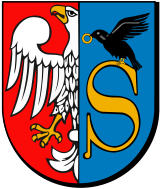Zwoleń
| Zwoleń | ||
|---|---|---|
|
15th-century church in Zwoleń | ||
| ||
 Zwoleń | ||
| Coordinates: 51°21′25″N 21°35′2″E / 51.35694°N 21.58389°ECoordinates: 51°21′25″N 21°35′2″E / 51.35694°N 21.58389°E | ||
| Country |
| |
| Voivodeship | Masovian | |
| County | Zwoleń County | |
| Gmina | Gmina Zwoleń | |
| Established | 1425 | |
| Town rights | 1425 | |
| Government | ||
| • Mayor | Bogusława Jaworska | |
| Area | ||
| • Total | 15.78 km2 (6.09 sq mi) | |
| Population (2006) | ||
| • Total | 8,176 | |
| • Density | 520/km2 (1,300/sq mi) | |
| Time zone | CET (UTC+1) | |
| • Summer (DST) | CEST (UTC+2) | |
| Postal code | 26-700 | |
| Area code(s) | +48 48 | |
| Car plates | WZW | |
| Website | http://www.zwolen.pl | |
Zwoleń [ˈzvɔlɛɲ] (Yiddish: זוואלין Zvolin) is a town in Poland, in Masovian Voivodeship, about 30 kilometres (19 miles) east of Radom. It is the capital of Zwoleń County. Population is 8,048 (2009).[1] Zwoleń belongs to Sandomierz Land of the historic province of Lesser Poland, and is located on the Zwoleńka river. The town has a sports club Zwolenianka, founded in 1923.
The history of the town dates back to the early 15th century, when Zwoleń was founded on a privillege issued by King Władysław Jagiełło. In the 16th century, it already was a center of local trade, located along the road from Lublin to Radom and Greater Poland. In 1566–1575, Jan Kochanowski worked at a local Roman Catholic parish. At that time, the town belonged to Sandomierz Voivodeship.
During the Swedish invasion of Poland (see Deluge, 1655 - 1660), Zwoleń was destroyed to such a degree, that it never recovered. In late 18th century, during Partitions of Poland, Zwoleń was annexed by the Austrian Empire. Since 1807, it was part of Duchy of Warsaw, which in 1815 became Congress Poland, a protectorate of the Russian Empire. After January Uprising, Russian authorities deprived Zwoleń of its town rights, as a punishment for residents' support of the rebels. The village of Zwoleń stagnated for years, and did not regain its town rights until 1925. In 1921 Zwoleń had 8,544 residents, of which 3,787 were Jews.
World War II
The Nazi German invasion of Poland was disastrous for the town. Almost 80% of buildings were destroyed in air attacks and artillery bombardments. Houses around the market square and the local synagogue were burned. German occupiers carried out numerous mass executions of underground resistance fighters (from Home Army to Bataliony Chłopskie). At the beginning of 1941, the Nazi administration established a ghetto in the southern part of Zwoleń for local Jews as well as all transports from neighbouring villages. In March 1941, Jews from Przytyk were transferred to Zwoleń (fact disputed by some scholars claiming that by then Jews of Przytyk were already removed).[2] On December 22, 1941 the Jüdischer Wohnbezirk was formally registered. By April 1942, the unfenced, open ghetto had some 4,500 inhabitants living in 239 houses (7 per room on average). Hundreds were homeless. On August 19–20, 1942 approximately 5,000 Jews were shipped in from Gniewoszów ghetto nearby. The Germans also brought to the ghetto Jews from other locations (Janowiec, Pionki, Jedlnia, Garbatka), further increasing their numbers. It is estimated that prior to mass deportations there were 6,500–10,000 Jews living there (top estimate by historian Adam Rutkowski has also been disputed).[2] The Zwoleń ghetto was liquidated on 29 September 1942. All inmates (about 8,000 according to Daniel Blatman)[3] were made to walk 15 kilometres (9 miles) to the railway station in Garbatka. A few hundred prisoners unable to walk were shot along the way. From there, all Jews were transported in Holocaust trains to Treblinka extermination camp.[4]
Postwar development
In 1954, a new Zwoleń County of Kielce Voivodeship was created, which was a great boost to the town economy. Factories and new schools were opened including a meat plant and a branch of Radom’s Łucznik Arms Factory. In 1975, after administrative reform of the communist Poland, all counties were dismissed, and Zwoleń became part of Radom Voivodeship. Zwoleń County returned in 1999 following the collapse of the Soviet empire.
The town is located in southeastern corner of Mazovian Voivodeship, at the crossroads of two national roads: the 79th (Warsaw - Sandomierz - Kraków - Bytom), and the 12th (Łęknica - Dorohusk). Zwoleń does not have a rail station, but maintains bus connections with several towns and cities. The town has a sports club Zwolenianka and other sports associations. Every year in late June, The "Name day of Pan Jan" ("Imieniny Pana Jana") Festival takes place there, in memory of Jan Kochanowski. The poet himself is buried at the local Catholic church of the Holy Cross.
People
- Stanisław Chomętowski
- Jan Karol Tarło
- Stanisław Tarło
- Rabbi Shmuel Eliyohu Taub of Zvolin, Modzitz (Hasidic dynasty)
- Jan Kochanowski (1530–1584)
- Leib Malach (1894—1936), a poet and a playwright
International relations
Twin towns — Sister cities
Zwoleń is twinned with:
References
- ↑ "Archived copy". Archived from the original on November 27, 2011. Retrieved September 23, 2009.
- 1 2 Geoffrey P. Megargee; Christopher Browning; Martin Dean. "Radom Region by Jolanta Kraemer". The United States Holocaust Memorial Museum Encyclopedia. Indiana University Press. pp. 355–356. ISBN 0253355990. Retrieved April 9, 2012.
- ↑ Daniel Blatman. Translated from the Hebrew by Judy Montel (Summer 2003). Zwolen. Pinkas HaKehillot, Polen, Volume VII (Jerusalem: Yad Vashem, 1999), pages 187-189. Kielce-Radom SIG Journal Volume 7, Number 3. pp. 8–9.
- ↑ "The Zwolen Ghetto". Jewish Ghettos. Holocaust Education & Archive Research Team. 2012. Retrieved April 9, 2012.
External links
| Wikimedia Commons has media related to Zwoleń. |
- Official town webpage
- Jewish Community in Zwoleń on Virtual Shtetl

